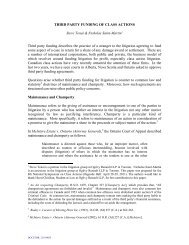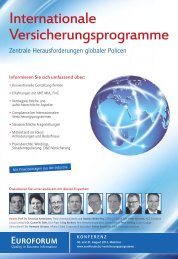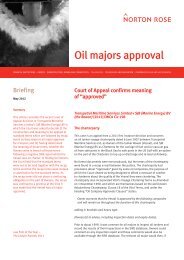The Act Implementing the AIFM Directive - Norton Rose
The Act Implementing the AIFM Directive - Norton Rose
The Act Implementing the AIFM Directive - Norton Rose
Create successful ePaper yourself
Turn your PDF publications into a flip-book with our unique Google optimized e-Paper software.
Ano<strong>the</strong>r aspect of <strong>the</strong> fund definition, i.e. that investors cannot directly access or control <strong>the</strong><br />
assets of <strong>the</strong> fund, is stated in clauses 33 and 34 of <strong>the</strong> Discussion Paper.<br />
Accordingly, a managed account does not qualify as a collective investment undertaking as it<br />
lacks <strong>the</strong> element of collectivity and <strong>the</strong> holder – in addition to <strong>the</strong> manager of <strong>the</strong> account –<br />
retains or, in any event, may resume its power of disposal. This would also apply if a group of<br />
investors opened a joint account or securities custody account and an asset manager was<br />
granted authority with respect to <strong>the</strong> account. This will mainly be <strong>the</strong> case if <strong>the</strong> portfolio<br />
management is outsourced to an asset manager. Ra<strong>the</strong>r than <strong>the</strong> asset manager level, <strong>the</strong><br />
collective investment undertaking is only created at <strong>the</strong> level of <strong>the</strong> outsourcing fund. This<br />
opinion is confirmed by section 36 sub-section 1 no. 3 KAGB-E, according to which an outsourced<br />
provider requires a licence for individual asset management or financial portfolio management.<br />
1.2.3 Criterion: capital raising<br />
<strong>The</strong> wording of <strong>the</strong> criterion “capital raising” requires an activity on part of <strong>the</strong> investment<br />
asset pool. This means that processes of a purely passive nature are excluded from its scope.<br />
Hence, if several persons come toge<strong>the</strong>r and actively pool money, this can conceptually no<br />
longer be considered as “capital raising”.<br />
<strong>The</strong> Discussion Paper also picks up ano<strong>the</strong>r aspect by pointing out that any capital raising<br />
which is not intended to deliver an investment return or profit should not be considered<br />
an AIF, because <strong>the</strong> concept of capital raising has a commercial component. <strong>The</strong> example<br />
scenario given in <strong>the</strong> Discussion Paper is that a group of householders purchases a piece of<br />
neighbouring land to use it as a common area.<br />
1.2.4 Criterion: number of investors<br />
As regards <strong>the</strong> criterion “number of investors”, section 1 sub-section 1 sentence 3 KAGB-E<br />
states that this criterion is met,<br />
“if <strong>the</strong> investment conditions, <strong>the</strong> articles of association or <strong>the</strong> instrument of<br />
incorporation of <strong>the</strong> collective investment undertaking do not limit <strong>the</strong> number of<br />
possible investors to one single investor.”<br />
<strong>The</strong> <strong>Act</strong> <strong>Implementing</strong> <strong>the</strong> <strong>AIFM</strong> <strong>Directive</strong><br />
<strong>Act</strong>ually, <strong>the</strong> same criterion as <strong>the</strong> requirement of a collective vehicle is referred to here.<br />
Where a number of investors is conceptually excluded, only individual management can exist.<br />
In particular, wholly-owned group companies are thus exempt from <strong>the</strong> scope of <strong>the</strong> KAGB-E.<br />
However, in cases o<strong>the</strong>r than <strong>the</strong> clear cases of individuals or legal persons, <strong>the</strong> question of<br />
<strong>the</strong> definition of “investor” arises. In view of <strong>the</strong> fact that <strong>the</strong> KAGB-E’s purpose is to cover<br />
only collective investment situations, <strong>the</strong> relevant criterion is whe<strong>the</strong>r <strong>the</strong> single investor<br />
acts as a single legal entity. This is affirmed in cases of joint ownership – both with regard to<br />
commercial partnerships and civil law partnerships.<br />
But if a trustee acts as intermediary for several investors, <strong>the</strong> criterion of <strong>the</strong> single investor<br />
is not fulfilled. Clause 29 of <strong>the</strong> Discussion Paper describes a case where a representative<br />
acts on behalf of a number of investors. This is relevant, in particular, in <strong>the</strong> case of a trustee<br />
acting as limited partner – a structure which is commonly used for closed-ended funds.<br />
Formally, a trustee who acts as limited partner is a single investor. But since, economically,<br />
<strong>the</strong> trustee is not to carry any rewards or risks itself, <strong>the</strong> Discussion Paper looks through <strong>the</strong><br />
trustee to <strong>the</strong> investors.<br />
<strong>Norton</strong> <strong>Rose</strong> December 2012 05













